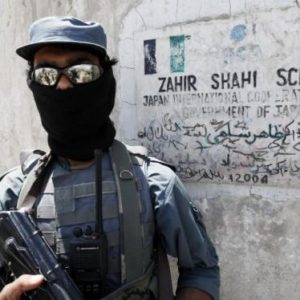Since the US-led military intervention in Afghanistan in 2001, foreign donors have invested heavily in education, building schools, supporting teacher training, and providing textbooks and other materials to schools across Afghanistan. But as the country’s security situation has deteriorated, schools throughout Afghanistan have been under threat, not only from resurgent Taliban forces but also from the very Afghan state security forces mandated to protect them.
Increasingly, the country’s security forces have been using schools—the only concrete-reinforced buildings in some villages—as their military bases during offensives against Taliban-held areas. Even if the buildings remain unscathed, military occupation interrupts children’s education. But all too often, the schools become battlegrounds as the Taliban counterattack government positions, leaving the buildings damaged or in ruins and denying children an education until they can be rebuilt, if ever.
This use of schools has placed schools at risk of attack and students and teachers in harm’s way. It is also contrary to the global Safe Schools Declaration, which Afghanistan endorsed in 2015. The declaration urges parties to armed conflicts “not to use schools and universities for any purpose in support of the military effort.”
Based on a research mission in April 2016, this report documents the occupation or other use for military purposes of 12 schools in one area of Baghlan province in north-eastern Afghanistan. Although conditions in Baghlan reflect the particular dynamics of the conflict in the northeast, where tensions between local security forces and government officials have erupted over military policy, security forces have used schools in other conflict-affected areas of the country as well, and statistics provided by the United Nations indicate that the problem is getting worse. The use of schools by Afghan security forces has severely harmed children’s right to education in Afghanistan, affecting tens of thousands of school children at all levels of education, and thousands of teachers and education administrators.
For example, the Ustad Ghulam Jelani Jalali Middle School in the village of Postak Bazaar was first occupied by Afghan security forces in 2010. The Taliban attacked and gunned down seven policemen inside a classroom. “Their blood just wouldn’t wash away,” a school official told Human Rights Watch, “so we had to chip it away from the wall with an axe.”In 2015, government forces were back at the school, setting up base with sandbagged positions on the second floor while students tried to continue their schooling below. Alarmed school officials managed to get a letter from the Kabul authorities ordering the government forces to leave, but the commander ignored them, saying that he was staying put. When the students needed to take exams, school officials again presented the letter to the commander, but his officers fired their guns in the direction of the assembled teachers and students, and they fled.
The Taliban, too, have used schools in Baghlan as bases. For example, a Swedish government-financed school in Omarkhail opened its doors in 2015 to 350 boys and girls. Soon afterward, Taliban fighters came to occupy the school, and were unwilling to leave when asked by village elders. In early 2016, government forces attacked the Taliban forces based at the school, raking the building with gunfire and mortar rounds. The Taliban fled, but the school compound was left in ruins less than a year after it had opened.
Incidents like these have become frequent occurrences, as school districts across the country find themselves on the front lines in country’s armed conflict. Either students attend schools being used by soldiers, putting themselves at grave risk, or they are deprived of an education until they can find facilities elsewhere.
One frequently noted achievement of the post-Taliban government in Afghanistan has been the increase in girls attending school. However, parents are especially unlikely to allow girls to attend school if the school is being used by the military or is believed to be at risk of attack. When parents perceive that a school or the route to the school is becoming more dangerous, or when a school closes and students are forced to travel farther to one that is still open, girls are far more likely than boys to be kept home by anxious parents.
Before 2001, decades of unrelenting conflict in Afghanistan had decimated the education system, depriving entire generations of an education. Under the Taliban government, the schools kept out girls and many others—and they focused on teaching the Taliban’s brand of Islam. When the Taliban government fell in late 2001, only about 775,000 children were in school, the World Bank estimated. Today some 8 million students are enrolled in school.
Since the US-led military intervention in Afghanistan, many donor countries focused a significant amount of their reconstruction efforts in trying to rebuild the country’s ruined educational infrastructure. Between 2002 and 2012, the US Agency for International Development (USAID) invested US$885 million in education projects in Afghanistan, and overall official development assistance (ODA) amounts to more than $450 million.[1] More than 33 donors have invested $400 million since 2009 in the government’s World Bank-supported Education Quality Improvement Project.[2]
Although reconstruction efforts have often been marred by inadequate oversight, wasteful spending, and widespread corruption, over the years thousands of schools have been constructed or refurbished throughout Afghanistan, an effort often claimed as a key achievement in the 15 years since the US-led intervention in Afghanistan. That achievement is at risk so long as schools remain vulnerable to use by military forces and threatened with attack.
Source: Human Rights Watch


